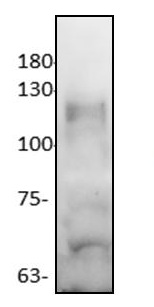BRD2 Antibody
Purified Rabbit Polyclonal Antibody
- SPECIFICATION
- CITATIONS
- PROTOCOLS
- BACKGROUND

Application
| WB |
|---|---|
| Primary Accession | Q6MGA9 |
| Reactivity | Human, Mouse, Rat |
| Host | Rabbit |
| Clonality | Polyclonal |
| Isotype | Rabbit IgG |
| Calculated MW | 88051 Da |
| Gene ID | 294276 |
|---|---|
| Other Names | RING3, RNF3; Bromodomain containing 4 |
| Target/Specificity | BRD2 |
| Formulation | 100 µg (0.5 mg/ml) of antibody in PBS, 0.01 % BSA, 0.01 % thimerosal, and 50 % glycerol, pH 7.2 |
| Handling | The antibody solution should be gently mixed before use. |
| Background Descriptions | |
| Precautions | BRD2 Antibody is for research use only and not for use in diagnostic or therapeutic procedures. |
| Name | Brd2 |
|---|---|
| Synonyms | Ring3 |
| Function | Chromatin reader protein that specifically recognizes and binds histone H4 acetylated at 'Lys-5' and 'Lys-12' (H4K5ac and H4K12ac, respectively), thereby controlling gene expression and remodeling chromatin structures. Recruits transcription factors and coactivators to target gene sites, and activates RNA polymerase II machinery for transcriptional elongation. Plays a key role in genome compartmentalization via its association with CTCF and cohesin: recruited to chromatin by CTCF and promotes formation of topologically associating domains (TADs) via its ability to bind acetylated histones, contributing to CTCF boundary formation and enhancer insulation. Also recognizes and binds acetylated non-histone proteins, such as STAT3. Involved in inflammatory response by regulating differentiation of naive CD4(+) T-cells into T-helper Th17: recognizes and binds STAT3 acetylated at 'Lys-87', promoting STAT3 recruitment to chromatin. In addition to acetylated lysines, also recognizes and binds lysine residues on histones that are both methylated and acetylated on the same side chain to form N6-acetyl-N6-methyllysine (Kacme), an epigenetic mark of active chromatin associated with increased transcriptional initiation. Specifically binds histone H4 acetyl- methylated at 'Lys-5' and 'Lys-12' (H4K5acme and H4K12acme, respectively). |
| Cellular Location | Nucleus {ECO:0000250|UniProtKB:P25440}. Chromosome {ECO:0000250|UniProtKB:P25440}. Note=Detected on chromatin and nucleosomes. {ECO:0000250|UniProtKB:P25440} |

Thousands of laboratories across the world have published research that depended on the performance of antibodies from Abcepta to advance their research. Check out links to articles that cite our products in major peer-reviewed journals, organized by research category.
info@abcepta.com, and receive a free "I Love Antibodies" mug.
Provided below are standard protocols that you may find useful for product applications.
Background
The acetylation of histone lysine residues plays a crucial role in the epigenetic regulation of gene transcription. A bromodomain is a protein domain that recognizes acetylated lysine residues such as those on the N-terminal tails of histones. This recognition is often a prerequisite for protein-histone association and chromatin remodeling. These domains function in the linking of protein complexes to acetylated nucleosomes, thereby controlling chromatin structure and gene expression. Thus, bromodomains serve as “readers” of histone acetylation marks regulating the transcription of target promoters. The BET family of proteins, defined by tandem Bromodomains and an Extra Terminal domain, include BRD2, BRD3, BRD4, and BRDT. The BET proteins play a key role in many cellular processes, including inflammatory gene expression, mitosis, and viral/host interactions. The isolated individual or tandem bromodomains of BRD2 and BRD4 have been shown to bind acetylated histone tails, serving to couple histone acetylation marks to the transcriptional regulation of target promoters. Small molecule inhibitors of these interactions hold promise as useful therapeutics for human disease.
If you have used an Abcepta product and would like to share how it has performed, please click on the "Submit Review" button and provide the requested information. Our staff will examine and post your review and contact you if needed.
If you have any additional inquiries please email technical services at tech@abcepta.com.













 Foundational characteristics of cancer include proliferation, angiogenesis, migration, evasion of apoptosis, and cellular immortality. Find key markers for these cellular processes and antibodies to detect them.
Foundational characteristics of cancer include proliferation, angiogenesis, migration, evasion of apoptosis, and cellular immortality. Find key markers for these cellular processes and antibodies to detect them. The SUMOplot™ Analysis Program predicts and scores sumoylation sites in your protein. SUMOylation is a post-translational modification involved in various cellular processes, such as nuclear-cytosolic transport, transcriptional regulation, apoptosis, protein stability, response to stress, and progression through the cell cycle.
The SUMOplot™ Analysis Program predicts and scores sumoylation sites in your protein. SUMOylation is a post-translational modification involved in various cellular processes, such as nuclear-cytosolic transport, transcriptional regulation, apoptosis, protein stability, response to stress, and progression through the cell cycle. The Autophagy Receptor Motif Plotter predicts and scores autophagy receptor binding sites in your protein. Identifying proteins connected to this pathway is critical to understanding the role of autophagy in physiological as well as pathological processes such as development, differentiation, neurodegenerative diseases, stress, infection, and cancer.
The Autophagy Receptor Motif Plotter predicts and scores autophagy receptor binding sites in your protein. Identifying proteins connected to this pathway is critical to understanding the role of autophagy in physiological as well as pathological processes such as development, differentiation, neurodegenerative diseases, stress, infection, and cancer.


